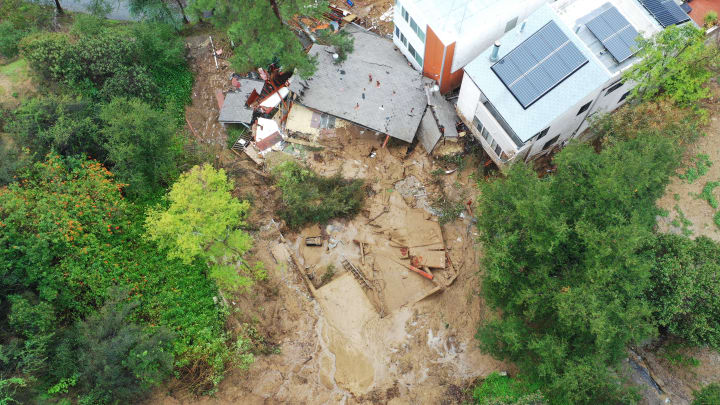What Is an Atmospheric River?
Atmospheric rivers exist to take moisture out of the tropics and spread it around the world. But it’s not pretty.

Meteorologists have described recent deluges in California with a captivating weather buzzword: atmospheric river. It doesn’t just sound scary—these ribbons of tropical moisture can actually cause terrifying floods, mudslides, and damage to roads and homes.
An atmospheric river is a narrow band of warm precipitation that can span thousands of miles in length. They occur from the tropics to the mid-latitudes. Atmospheric rivers aren’t actual rivers, of course, but it’s a pretty good description of a feature that resembles a river on satellite imagery and can bring torrents of water to unlucky communities as the system comes ashore.
These rivers are the result of sprawling low-pressure systems that form just far enough south that their counter-clockwise circulation scoops up water vapor from the tropics and transports it northward. The storms that cause atmospheric rivers to form in the first place are usually able to generate enough upward lift to create precipitation. Mountains can play a role—they’re very effective at wringing moisture out of the atmosphere as wind travels up the side of their terrain. Whether it’s rain or snow, any precipitation that forms within that band of elevated moisture levels can be quite heavy, producing steep rainfall totals and many feet of snow in extreme cases.
What Is the “Pineapple Express”?
California has a reputation for calm, sunny weather, but the state never really has it easy when it comes to dealing with nature’s temper tantrums. Within the past decade, the state was mired in a devastating drought that was finally broken in 2017 as one storm after another roared in from the Pacific and drenched the state with unmanageable amounts of heavy rain. The driving force that gave each storm its bulk was an atmospheric river. Without it, there wouldn’t have been much moisture for the storm systems to work with.
An atmospheric river that affects the West Coast—and California in particular—is usually nicknamed a Pineapple Express since the source of the tropical moisture is the area around Hawaii. Atmospheric rivers without a cool nickname are also common over the eastern half of the United States during the warm season. Many of the major flash floods that occur in the eastern U.S. during the summer months are the result of intense thunderstorms tapping into the bountiful moisture present in an atmospheric river flowing over the region.
All weather is the result of nature trying to balance out inequality, and atmospheric rivers, just like every other weather condition, serve this purpose. Wind blows from areas of high air pressure to areas of lower pressure in an attempt to erase the inequality of more air molecules over one spot than another. The jet stream is the direct result of sharp temperature differences between the tropics and the poles. Hurricanes exist to transport heat from the tropics to the poles. Atmospheric rivers exist to take moisture out of the tropics and spread it around the world.
Though atmospheric rivers seem difficult to enjoy, we’d be in some pretty big trouble without them. In 1998, a study by MIT scientists reported that 90 percent of all the moisture transfer between the tropics and the rest of the world each year occurs within these narrow bands.
A version of this story was published in 2017; it has been updated for 2024.
More Stories About Weather and Climate
manual